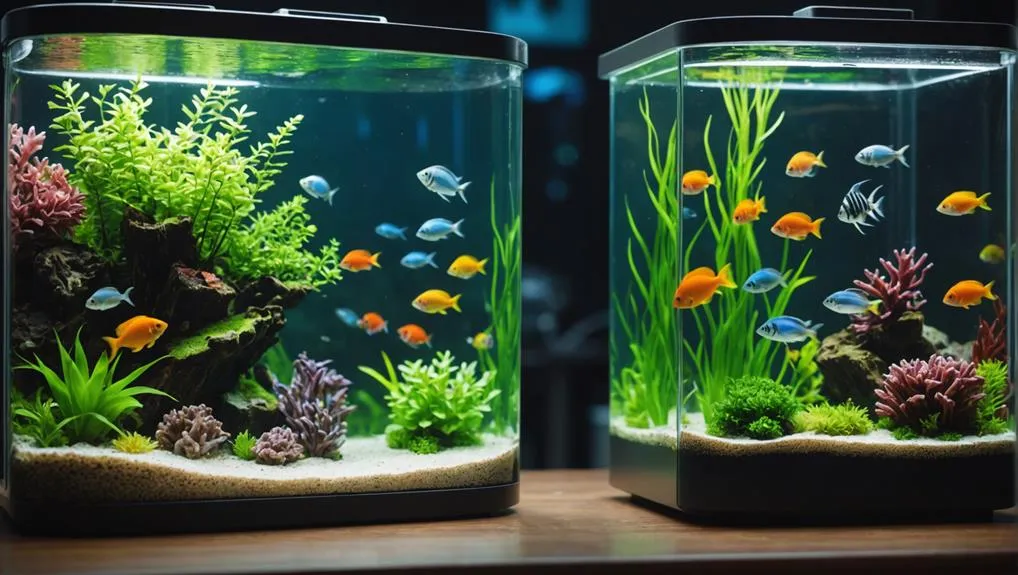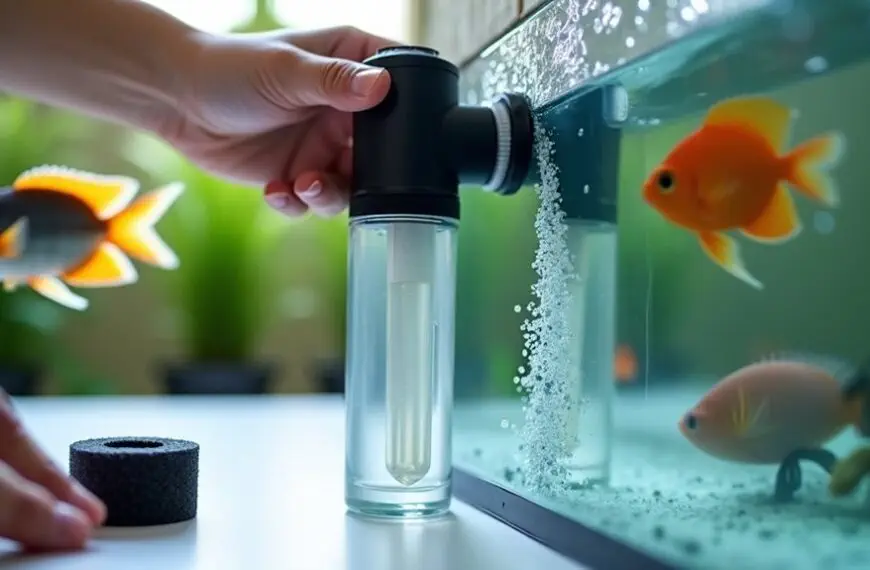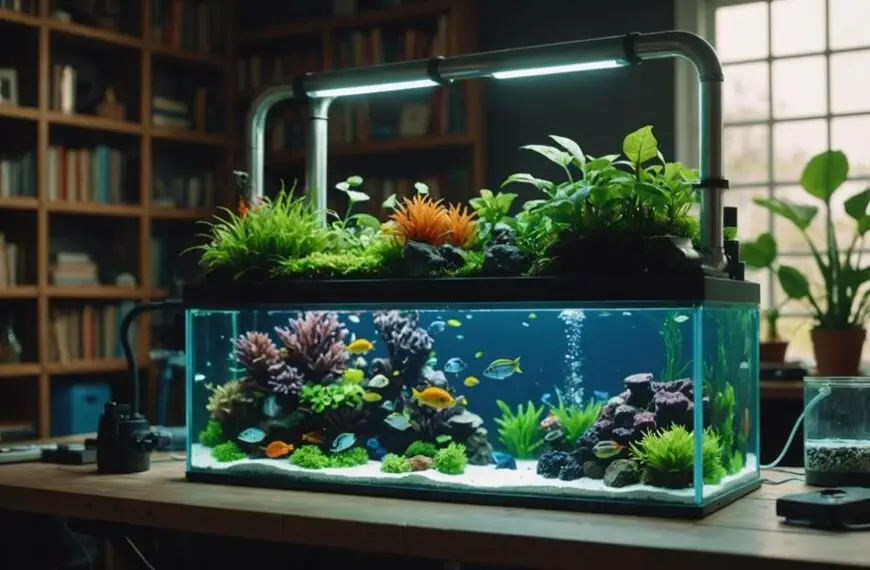Canister and sponge filters are both essential for keeping your aquarium healthy, but they're quite different! Canister filters offer powerful, customizable filtration suitable for larger tanks. They require more maintenance and have a higher price tag, but they handle bigger fish populations like pros. On the other hand, sponge filters are perfect for smaller tanks and gentle fish, offering low-cost, low-maintenance care. They might not win any beauty contests, but they do a great job nurturing beneficial bacteria. So, whether you're a novice or a seasoned hobbyist, there's a filter for you—stick around to explore your options!
Contents
Overview of Filter Types
When it comes to aquarium filtration, understanding the differences between canister and sponge filters is essential for maintaining a healthy aquatic environment.
As an aquarium hobbyist, you want to make the best choice for your underwater friends, and knowing how these filters work can help you do just that.
Canister filters are external systems that offer a robust filtration solution. They utilize multiple filter media trays, providing excellent mechanical, chemical, and biological filtration.
If you've got a larger tank, say between 10 to 400 gallons, canister filters can handle the bioload like a pro.
On the flip side, sponge filters are simpler and budget-friendly, perfect for beginners or smaller tanks. They usually focus on mechanical and biological filtration through a sponge that lives right in the water.
Plus, they create a gentle current, which is a big win for delicate fish or fry.
Sponge Filter Features
When it comes to sponge filters, you're not just saving money; you're also getting a powerful ally in keeping your tank clean.
These filters work hard to trap debris while nurturing beneficial bacteria, which is essential for maintaining healthy water quality, giving you efficient filtration without breaking the bank.
Plus, with their long lifespan and minimal upkeep, you'll have more time to enjoy your fish instead of stressing over expensive equipment!
Cost-Effectiveness
Sponge filters stand out as a cost-effective solution for aquarium enthusiasts looking to maintain a healthy aquatic environment without breaking the bank.
If you're budget-conscious, you'll love that sponge filters usually cost less than $2 each. In contrast, canister filters can drain your wallet before you even get them set up! Plus, these little gems can last up to a decade with proper care, which means fewer replacement costs over time.
The minimal ongoing maintenance and few replacement parts needed make sponge filters an economical choice for anyone. You won't be scrambling to buy expensive components every few months.
The durable materials used in sponge filters also enhance their cost-effectiveness, ensuring you get reliable filtration systems without the hefty price tag.
If you think about it, sponge filters often outperform their pricier counterparts in filtration efficiency relative to their lower price point. So, you're not just saving money; you're maximizing your value as an aquarium owner.
With sponge filters, you can enjoy a thriving aquatic habitat while keeping your budget intact. Now, that's a win-win!
Filtration Efficiency
Not only do sponge filters save you money, but they also excel in filtration efficiency. These filters offer both mechanical and biological filtration, making them a powerhouse for keeping your aquarium clean. They trap debris effectively while supporting beneficial bacteria growth, which is essential for maintaining water quality.
The high surface area of sponge filters helps these bacteria thrive, reducing harmful ammonia and nitrite levels that can stress your fish. You'll appreciate how gentle the water flow is with sponge filters, especially if you have delicate species. This gentle flow minimizes stress and avoids turbulence, creating a cozy environment for your aquatic friends.
Plus, by agitating the water surface, sponge filters promote oxygen exchange, keeping those oxygen levels just right. With low maintenance requirements, sponge filters deliver consistent filtration efficiency. Cleaning and replacing them is a breeze, so you can spend more time enjoying your aquarium rather than worrying about it.
With sponge filters, you're not just filtering water; you're creating a healthy habitat for your fish. So, if you want to serve your aquatic community well, a sponge filter might just be your new best friend!
Canister Filter Features
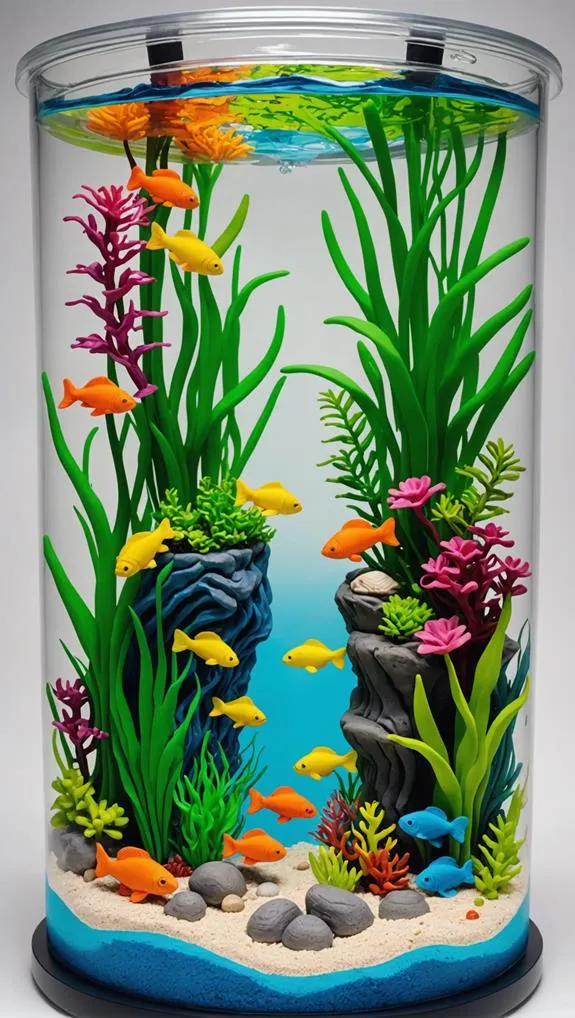
Canister filters stand out for their robust design and efficiency, making them ideal for larger aquariums. If you're looking to create a thriving underwater community, you'll appreciate how these filters can handle tanks ranging from 10 to 400 gallons.
They come equipped with multiple trays of filter media, ensuring that mechanical, biological, and chemical filtration happen all at once. This means you'll enjoy superior water quality, which is a win for both you and your aquatic friends!
One of the great features of canister filters is their customizable water flow rates. You can easily adjust them with regulators, making it simple to match the needs of different fish and tank conditions. Plus, the external plumbing keeps things neat by minimizing in-tank equipment.
However, be prepared for some maintenance. While canister filters tend to be quieter than others, they do require regular disassembly and cleaning to prevent clogging. Think of it as a little chore that pays off with crystal-clear water.
Pros and Cons Comparison
When it comes to picking between canister and sponge filters, you've got some important factors to consider.
For instance, canister filters are like the overachievers of the aquarium world, offering top-notch filtration but can be a bit high-maintenance.
On the flip side, sponge filters are the friendly, low-cost option that keeps things easy, especially for smaller tanks or gentle fish.
Filtration Efficiency Comparison
While both canister and sponge filters serve crucial roles in aquarium filtration, their efficiency varies significantly based on the specific needs of your tank.
If you have a bustling community of fish, a canister filter might be your best friend. It boasts higher filtration capacity, handling larger bioloads thanks to its multiple trays for mechanical, biological, and chemical filtration.
On the flip side, sponge filters excel in maintenance frequency, requiring only a quick rinse now and then.
When it comes to oxygen exchange, sponge filters shine by creating surface agitation, keeping your fish happy and healthy.
Canister filters, however, can struggle with this due to their enclosed design.
Flow rate is another important factor. Canister filters allow you to customize the flow, making them versatile for different aquatic environments.
Sponge filters, while gentle, mightn't be suitable for all tank setups.
In terms of cost efficiency, sponge filters win again, with lower initial costs and minimal ongoing expenses.
Maintenance Requirements Overview
In choosing between canister and sponge filters, understanding their maintenance requirements is essential.
You'll want to think about how much time and effort you're willing to invest in keeping your aquarium clean and happy.
Here are three key points to consider:
- Frequency of Cleaning: Canister filters need disassembly and cleaning every month, while sponge filters typically only require cleaning every few months, depending on waste levels.
- Ease of Maintenance: Sponge filters can be rinsed right in the tank, making maintenance a breeze. On the other hand, canister filters require a power shutdown, which can feel like a mini project each time.
- Complexity: Sponge filters have a simple design, making them user-friendly. Canister filters, however, involve trips to the hardware store for replacement parts, which can add up over time.
While canister filters might offer better filtration in larger tanks, the maintenance of sponge filters is generally less labor-intensive.
We all want to serve our aquatic friends well, and choosing the right filter can make that a lot easier!
Cost Analysis Breakdown**
Choosing the right filter also involves considering the cost, which can significantly impact your overall aquarium budget.
If you're a budget-conscious aquarist, you'll appreciate the affordability of sponge filters. They usually cost under $2, while canister filters start at around $50 and can soar into the hundreds. That's a big difference!
When you think about operating costs, sponge filters shine again. They use less energy, keeping your electric bill in check. Canister filters, with their motorized parts, might drain your wallet over time.
Plus, don't forget about maintenance expenses. Sponge filters require minimal upkeep and rarely need replacements, which is a win! In contrast, canister filters often demand regular purchases for replacement media and parts.
Sponge filters also boast a longer lifespan—up to a decade with proper care. Canister filters, while sturdy, might need repairs down the line, adding to your long-term costs.
So, when you run a cost analysis, it's clear: for beginners or those watching their budget, sponge filters often come out on top.
They offer a perfect balance of low initial investment, minimal maintenance, and lasting durability. Your wallet will thank you!
Maintenance and Care
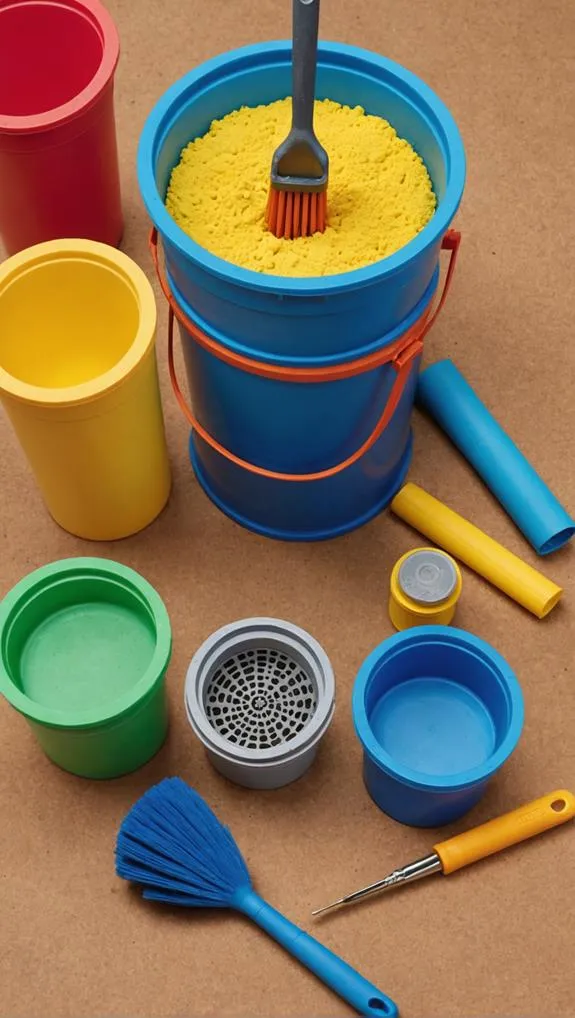
Maintaining your aquarium filter is crucial for keeping a healthy environment for your fish. Regular maintenance helps ensure your sponge filter operates effectively and continues to support beneficial bacteria, which are essential for breaking down waste.
Additionally, monitoring your water quality regularly, including checking ammonia and nitrite levels, can further enhance the effectiveness of your filter system and ensure a balanced ecosystem for your aquatic life (key water parameters to monitor).
Fortunately, sponge filters are pretty low-maintenance compared to their canister counterparts.
Here are three simple steps to care for your sponge filter:
- Monthly Cleaning: Rinse the sponge in aquarium water about once a month. This keeps beneficial bacteria intact while removing any gunk that can build up over time.
- Monitor Detritus: Keep an eye out for any detritus buildup. Keeping your sponge filter clean helps maintain a long operational lifespan and keeps your tank sparkling.
- Gentle Handling: When cleaning, be gentle. You don't want to disrupt the tank's ecosystem too much, as your fish depend on that balance.
Aesthetic Considerations
The appearance of your aquarium can significantly influence the overall enjoyment of your aquatic setup. When you're choosing a filter option, consider how it fits into your aquarium layout.
Canister filters are designed to be placed outside the tank, which means they keep the interior looking clean and uncluttered. This enhances the visual appeal, allowing you to create a stunning aquascape without distractions.
On the other hand, sponge filters often look bulky and can disrupt the aesthetic. Their visible presence inside the tank may not be what you'd in mind for your beautiful underwater world.
Many hobbyists find that canister filters, or even HOB (hang on back) filters, offer a more polished look than sponge filters. Plus, canister filters can be customized with various accessories that complement your design, making them a versatile choice.
If you're someone who prioritizes visuals over functionality, the aesthetic disadvantage of sponge filters might be a dealbreaker, especially in display tanks.
Choosing the Right Filter
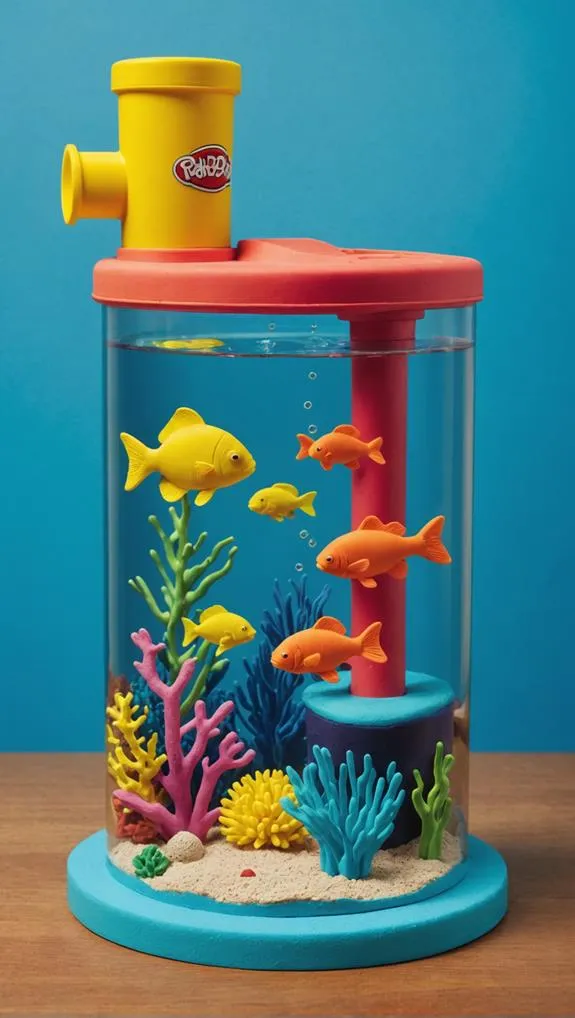
When it comes to selecting the right filter for your aquarium, various factors come into play that can make or break the health of your aquatic environment.
You want to ensure your fish thrive, so here are three key points to consider:
- Tank Size and Fish Type: Canister filters shine in larger tanks (10 to 400 gallons) and with heavy bio-loads, while sponge filters are perfect for smaller tanks and delicate species due to their gentle flow.
- Maintenance Requirements: If you prefer low-maintenance, sponge filters require less frequent cleaning compared to the more complex canister filters, which often demand more time and care.
- Initial Investment: If you're just starting out, sponge filters are your budget-friendly option. They've a lower initial investment compared to canister filters, which can be a bit pricey upfront and might lead to ongoing costs.
Ultimately, think about your aquarium's needs and your own preferences.
With the right choice between sponge and canister filters, you can create a beautiful, thriving habitat for your aquatic friends!
Frequently Asked Questions
What Are the Cons of a Sponge Filter?
When using a sponge filter, you'll face maintenance challenges that can disturb water balance. Its size limitations restrict its use for larger tanks, and it's less effective for chemical filtration, impacting suitable fish species.
What Type of Filter Is Best for a Fish Tank?
Choosing the best filter for your fish tank depends on size, maintenance, and budget. Consider budget-friendly options like sponge filters for smaller setups, ensuring optimal water quality and lower power consumption, while following filter maintenance tips for longevity.
Why Use a Sponge Filter in an Aquarium?
Using a sponge filter in your aquarium enhances filtration efficiency while being gentle on delicate fish. It's budget-friendly, compatible with various tank sizes, simplifies maintenance, and promotes aquatic health improvement, ensuring a thriving environment for your aquatic friends.
Why Are Canister Filters Better?
Canister filters offer superior filtration efficiency, ensuring excellent water clarity with minimal maintenance requirements. They occupy less space in your tank and operate quietly, making them ideal for creating a peaceful aquatic environment for your fish.
Final Thoughts
So, when it comes to choosing between canister and sponge filters, think of it like picking between a sports car and a cozy family sedan. The canister offers powerhouse filtration, while the sponge gives you simplicity and ease. It's all about what fits your needs best! Whether you want high performance or laid-back maintenance, both filters can keep your tank healthy. Just remember, your fish will thank you for making the right choice!

